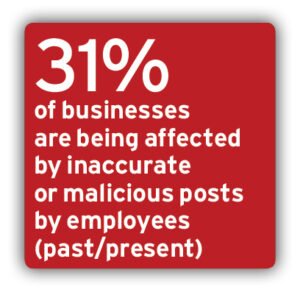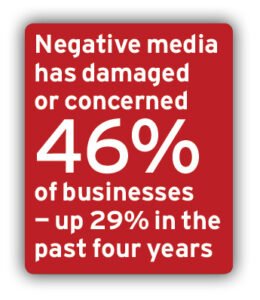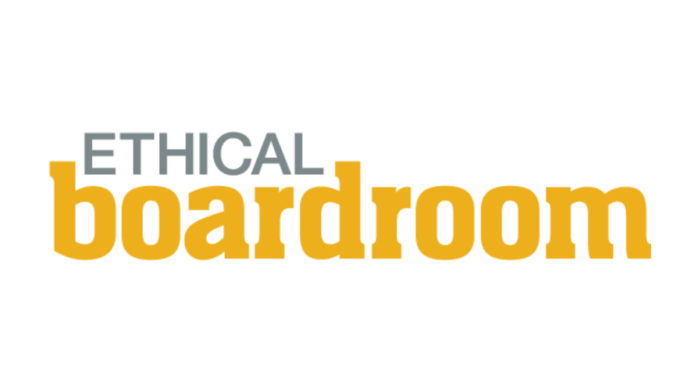We are living in a world where corporate online reputation really is everything in business. Online reputation influences and affects public perception, sales, profit… the list goes on.
As we continue to conduct more of our personal and professional lives in the online space, people routinely search for companies online before doing business with them. According to Forbes Magazine, 65 per cent of people now view the internet as their most trusted source of information, making mitigating reputation risk in today’s digital landscape a modern business essential.[1]
In a corporate era, where 90 per cent of us never move beyond the first page of each engine results, controlling, monitoring and maintaining a positive presence online is a priority.
Doing nothing is no longer an option
While general awareness of the need to understand and counter digital reputation risk is undoubtedly increasing, the complexity of the risks we’re facing are growing, too. Global networks, multi-channel working and the speed, transparency and reach of social media platforms, are all making it harder to remain in control of conversations about you and your company, brand or employees.

As a specialist in online reputation risk, every day I examine some of the most pressing reputation risks and challenges facing companies, brands and senior executives. When it comes to mitigating and managing the type of online reputational risk that can affect a company, brand, executives, employees – and their value – it really does pay to be in the know. Here, I’m shining a light on the specific risks facing businesses and the risks executives and employees pose to brand and company reputation, with recommended strategies to combat negativity and build an enduring, robust online presence.
When disaster strikes — big brands under fire
In recent years, I’ve seen some of the world’s biggest brands struggling to rebuild their corporate reputations after a series of major crises. Recent cases like Snapchat’s automated response to a system glitch and Marriott International and Talk Talk’s data breaches, all demonstrate the huge financial and reputational impact of not having a clear or workable strategy in place.
When Snapchat users reported issues with the platform’s ‘snapstreaks’ function
in July 2018, the social media provider responded to users’ concerns with a series
of automated messages. Unfortunately for them, people soon realised that the supposedly individual and sincere responses were, in fact, the work of bots. It wasn’t long before trolls were sending the bots irreverent messages – and sharing the joke worldwide. While the automated service was well-intentioned, and a good way to answer lots of queries at once, people hated being misled and lost trust in the brand, putting a big dent in its online reputation. When the bot system was exposed, Snapchat remained po-faced, instead of taking the chance to laugh and reclaim its fresh, modern image.

In this case, and across the board, trust and reputation are clearly linked – especially when companies are asking customers to provide sensitive data. So, if personal details are hacked or misused, brands need to act quickly to regain market confidence.
When Marriott International revealed 500 million customers had been hit by a data leak in November 2018 (the leaks happened several years earlier but news only became public in 2018), its share price dropped by 6.9 per cent overnight. Ongoing class action lawsuits, from travellers looking for compensation, are expected to leave the hotel giant with a multi-billion pound bill. Then there’s also the damaging loss of consumer confidence.
Talk Talk’s data breach – the most far-reaching of its kind – saw 21,000 sets of customer details stolen and a then record fine of £400,000 imposed by the Information Commissioner’s Office. While smaller businesses may not face huge data breaches or system glitches in the same way, they are vulnerable to potentially catastrophic negative content, including trolling, forum comments on trusted business sites, such as Money Saving Expert, from customers or employees, and negative or fake reviews.
All the above remain online and visible for many years and can cause a disproportionate amount of harm. Just one negative comment can lead to a highly toxic comment thread, denting consumer confidence and trust. Unfortunately, smaller businesses are less likely to have the resources in place to manage and counteract these attacks, so – as in all cases – having the right strategies and plans in place ahead of time is key.
Reputation risk — the challenge for companies and brands
Companies and brands are waking up to the importance of protecting their online reputations. Investing in professional reputation management services, actively monitoring online conversations and a more proactive approach to policing and responding to reviews are now all part of everyday marketing and PR functions. Throw in a solid crisis communications team and some expert social media management and you could be forgiven for thinking your online reputation is in safe hands.

But, as you would expect, in today’s fast-moving digital world, new threats are appearing with alarming regularity, often linked to the success and development of new online channels. So, it’s important to keep an eye on new technological and digital developments. As well as the benefits that recent innovations, such as apps and video content can bring (wider reach, better audience targeting), consider the potential reputation risks they pose too, and how you can prepare for them.
- Video content remains one of the fastest-growing marketing tools, giving brands and companies the ability to reach much wider audiences, but it can also be used to distribute negative content, so carries real risk. So how do you mitigate these while still harnessing video’s huge potential? How your company can create high-ranking, relevant video content that will appear prominently when people search for your brand
- It’s important to think about the kind of videos people are engaging with and sharing. How can you create something like this for your business?
- YouTube is an online force to be reckoned with – and mitigating risk means acknowledging its significance. Coming third only to Google as a search engine and Facebook as a social media platform, it is important to share content there – and be aware of any negativity it might hold
- Chatbots can be an effective way to deal with customer service issues quickly. When questioned in October 2018, customers in India, South Korea, Singapore and the US said chatbot messaging was their preferred communication channel.[2] But as the 2018 Snapchat case showed, chatbots carry an inherent risk. As an impersonal, automated service, they cannot always deliver the personalised service customers want – and when reputational issues are raised they may remain unrecognised
- Another major source of risk is negative content appearing on page one of a search and content placement. A 2018 Forbes report revealed businesses face losing almost a quarter (22 per cent) of potential leads when customers come across one negative page one search result article. When they spot three, 59 per cent of browsers turn off. Another 91.7 per cent of people never look further than page one search results – so be sure to audit yours regularly
- Take control by overpowering uncontrolled third-party content (forums, review platforms, etc) with your own controlled, owned and optimised profiles and websites. That way they are more likely to stay on page one. At the same time, create a consistent and ongoing published plan for content across third party sites
- Being aware of everything that is being said about your brand is vital, so make sure your monitoring service is working well – and capturing all data. Can you segment data? Think about measuring sentiment as well as volume to provide a clearer picture of your online reputation. Be aware that sentiment can be subjective and some online conversations are more transient than others. So, a negative tweet will have less impact than a negative news headline
- Understanding reach is also important – if a user has 10 followers it’s unlikely their content will go viral. If their audience is 60,000, you may have a problem

- Approach digital advertising carefully. Are you using an automated, target-led service? If so, make sure you know where ads are being placed and assess any reputational risk. Are they being placed in apps or across video? Can you find ways to examine setting and context to make sure your online reputation doesn’t suffer?
- Data protection and inappropriate or tasteless advertising are the most common reputational gaffes – so err on the conservative side when commissioning creative content. Relevant targeting is also key. Platforms provide audience targeting tools, but be aware of the General Data Protection Regulation (GDPR) regulation when using email marketing. Choosing a recognised marketing platform, such as the GDPR-compliant Mailchimp, will help
Review your reviews…
The power of peer-to-peer reviews shows no signs of dimming, with 95 per cent
of consumers saying they read online comments before making a purchase.[3]

Whether it’s customer-facing platforms, like Yelp and Google, or employee-specific sites, such as Glassdoor and Indeed, you need to be aware of what people are saying about your brand, services, employees and executives – and join the conversation. It’s no longer enough to simply monitor/gather reviews – genuine engagement is what customers are looking for.
According to contemporary research, review responses are closely observed. An overwhelming 82 per cent admit they actively look for bad reviews before deciding to buy and they spend four times as long interacting with negative comments.
There is a sliding scale – and ‘five out of five’ reviews may actually be too good to be true. Richard Shotton discusses this in his book The Choice Factory, citing evidence from Northwestern University. It looked at 111,000 product reviews and found that when product reviews are near perfect, 4.9 or five out of five stars, fewer people actually go on to buy that product. We should also consider the related phenomenon ‘reputation inflation’, where we tend to rate people highly in systems where the ratings are public and visible.[4]
What’s your CEO’s reputation strategy?
CEOs are a diverse bunch and for every one that is ‘out there’, happy to be the face of the brand boss, there are plenty of others who prefer relative anonymity. But in the digital age, leadership is a resource that must be carefully curated. CEOs must embrace their potential to be amazing online brand ambassadors.
When a Google employee criticised the company about its lack of diversity, chief executive Sundar Pichai quashed the online reputational risk with his own fast reaction. Breaking off from a family holiday to personally oversee the company’s response, he issued a clear statement to employees denouncing discrimination and attracted praise from business writers and analysts. But not everyone is as bold.
A recent social report says only 40 per cent of CEOs are active on social media and only 70 per cent use LinkedIn.[5] A survey from international PR firm Weber Shandwick, revealed that executives now feel that 45 per cent of their company reputation and 44 per cent of capital value is directly attributable to their CEO’s behaviour, with 50 per cent predicting that figure will continue to rise.[6] As a result, 81 per cent of bosses now feel that external CEO engagement is vital to building a strong business reputation.
THE OPPORTUNITIES OFFERED BY TODAY’S COMMERCIAL AND SOCIAL ONLINE LANDSCAPES ARE IMMENSE. BUT AS DIGITAL WORKING ADVANCES, SO TOO DO THE ASSOCIATED RISKS
This blurring of personal and professional boundaries takes careful management. Take the case of billionaire entrepreneur Elon Musk. The Tesla CEO is an avid Twitter user whose comments regularly affect the market value of his companies. So, when he accused a British rescue diver of sexually inappropriate behaviour, Tesla’s share price plummeted. Controversial tweets about the company’s finances and possible private ownership plans also saw Musk facing an investor backlash and fines, while a 2018 web link appearance where he smoked cannabis led to a fall in share prices by another six points.
Later, in November 2018, Robyn Denholm took over as chair of the Tesla board.
Joined up thinking — employees and reputation management
While leaders have the potential to create and add company value, employees – and this includes those at boardroom level – carry real risk in terms of day-to-day behaviours that go against company values as well as the threats of financial and data breaches. All must be included in any reputation management plan.
Having a clear reputation strategy, that sets our clear guidelines and expectations for online employee behaviour, is an important first step. Decide who will own the strategy and liaise with HR, IT and security departments to monitor for inappropriate or negative postings and behaviour. Clearly, employees don’t ever want to feel that they are being watched so bosses need to produce clear guidelines about access to information, social media use and appropriate workplace behaviour. The Information Commissioner’s Office provides advice on how to do this effectively and ethically. Identify key online assets and risk assess them – who needs access to them? How can this be supervised?
Conclusion
In summary, the opportunities offered by today’s commercial and social online landscapes are immense. But as digital working advances, so too do the associated risks.
Brands, companies, senior executives and employees all need to take responsibility for mitigating these risks; assessing, monitoring and managing risks; implementing preventative measures: and acting quickly when crisis hits. By doing all of the above, businesses and brands can continue to maximise the online opportunities available to them and build a robust and resilient online reputation that consumers trust and engage with.

